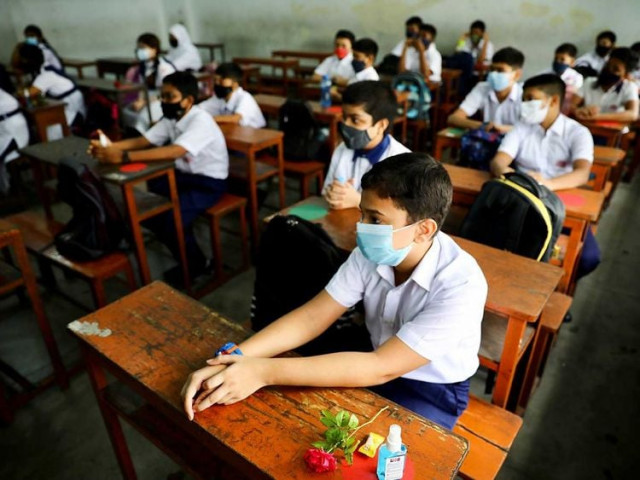Crisis stems from lack of education
2030s can demonstrate dramatic shift in Pakistan’s fortunes

Many are asking why Pakistan’s economy is in trouble? Is it purely global factors, like inflation and high energy prices, or are local causes more important, such as corruption or low tax collection? Some in Pakistan attribute it to a western conspiracy, aimed at keeping the country weak and dependent on the IMF, while some in the West see it as a Chinese conspiracy to keep Pakistan trapped in debt and dependent on Beijing.
The underlying answer to the first question becomes clear when a different question is asked, why is Pakistan looking more fragile than Bangladesh, even though both are seeking IMF loans? While 2022-23 will be hard for both, in the recently published book, The Time Travelling Economist, I outline why the whole of the 2020s will be harder for Pakistan. But the 2030s can demonstrate a dramatic and permanent shift in the country’s fortunes. No illiterate country has ever achieved prosperity. Literate elites have been able to build highly successful empires, from Imperial Rome to the Mughal Empire, but without mass literacy (in any language), countries have always remained poor.
A social scientist in the 1960s showed that countries with adult literacy below 40% had never grown sustainably, and that 70-80% adult literacy is required to industrialise. In the last set of comparable UN data, Pakistan’s adult literacy rate of 59% was the lowest for any emerging market and below that of Bangladesh at 72% or India at 74%. We can see why Bangladesh’s textile industry exports so much more than Pakistan.
You will know better than I do, why Pakistan has not already achieved the goal set in 1948 by the All Pakistan Education Conference for universal primary education, or the 1981 goal to achieve mass literacy. I wish I’d asked that question when I was last in Islamabad and Karachi. But if Pakistan can raise adult literacy by 1 percentage point a year in the 2020s, then in the 2030s it will be over 70% and ready to industrialise. Given the national security implications of faster GDP growth in industrialising India than Pakistan, the armed forces probably recognise how essential it is that literacy is expanded and especially among girls.
No country takes off if girls are uneducated. Human capital is half of the challenge for Pakistan. The other half is actual capital, the real cash needed to invest in infrastructure such as cheap, reliable electricity. Surprisingly, this is a function of fertility rates. When countries have a fertility rate above 5 children per woman – as Pakistan did as recently as 20 years ago – the average family has to spend all their earnings just to feed the children, leaving nothing leftover at the end of the week to save in a bank. Banking systems tend to be small, with deposits around 20% of GDP. The shortage of savings means the cost of money is high.
This is also true in Pakistan today, and because of high local interest rates, the country has borrowed heavily from abroad to fund the investment that Islamabad knows the country requires. By contrast, China’s low fertility rate means savings are plentiful, and the cost of money is so cheap that China has excess cash to lend to Pakistan. Why is Bangladesh not facing the same scale of debt problems that Pakistan is? Because the fertility rate in 2015-19 was 2.1 children per woman (similar to India’s 2.2) while it was 3.6 in Pakistan. Bangladesh has never borrowed from international financial markets by issuing a Eurobond, unlike Pakistan, because it has enough local savings to fund investment from its own banks. Bank lending in Bangladesh was about 45% of GDP in 2021, three times the 15% of GDP figure for Pakistan.
Infrastructure in Bangladesh has been built without excessive foreign borrowing. And external debt is much less of a burden; the ratio of external debt to exports in 2020 was around 200% in Bangladesh against over 400% in Pakistan. Again, there is good news on the horizon for Pakistan. UN forecasts last year said Pakistan will have a fertility rate of 3 children per woman in 2030 and 2.6 in 2040. Bank deposits will rise and bank lending too. In the 2030s, Pakistan should be able to self-finance its own investment and should not need to rely on IMF support or expensive Eurobonds.
But the 2020s will be tough. To meet the understandable demands of its people, Pakistan has borrowed heavily, and global borrowing costs have now soared. Any post-election government will need to tax the population more, or spend less, or default. Pakistan is not alone in this. Egypt, Ghana and others are in a similar leaky boat, and face the same hard choices. The good news for Pakistan is that the choices should be easier within a decade. Sri Lanka carries a final word of warning. It achieved the adult literacy to industrialise in the 1980s (and did), and achieved fertility rates below 3 children soon after. It was the most successful economy in South Asia.
But instead of enjoying the demographic dividend, war meant its savings were re-directed from essential investment to security spending. Then after the war ended in 2009, Sri Lanka attempted to catch up with Southeast Asia, and borrowed too much in the 2010s, while taxing its people too little. The lesson here is that in the 2030s and beyond, insecurity and conflict could still derail Pakistan’s much improved trajectory. We should all hope for a peaceful and prosperous Pakistan in coming decades.
THE WRITER IS THE GLOBAL CHIEF ECONOMIST OF RENAISSANCE CAPITAL, AN EMERGING AND FRONTIER MARKET-FOCUSED INVESTMENT BANK



















COMMENTS
Comments are moderated and generally will be posted if they are on-topic and not abusive.
For more information, please see our Comments FAQ